Introduction to the Sandakphu Trek
The Sandakphu Trek is a breathtaking journey through the Singalila National Park, offering stunning views of four of the world’s five highest peaks: Everest, Kangchenjunga, Lhotse, and Makalu. This trek, known for its panoramic vistas and rich biodiversity, is a must-do for adventure enthusiasts and nature lovers alike.
Situated at the border of India and Nepal, the Sandakphu Trek takes you through charming villages, lush forests, and high-altitude meadows. The trek’s highlight is the view of the “Sleeping Buddha” - a formation created by the Kangchenjunga range of peaks.
Best Time for the Sandakphu Trek
The best time for the Sandakphu Trek depends on what you want to experience:
- Spring (March to May): Ideal for clear views and blooming rhododendrons.
- Autumn (October to November): Perfect for stable weather and crisp mountain views.
- Winter (December to February): For those seeking a snow-covered landscape and a challenging trek.
Avoid the monsoon season (June to September) due to heavy rainfall and potential landslides.
Sandakphu Trek Distance and Altitude
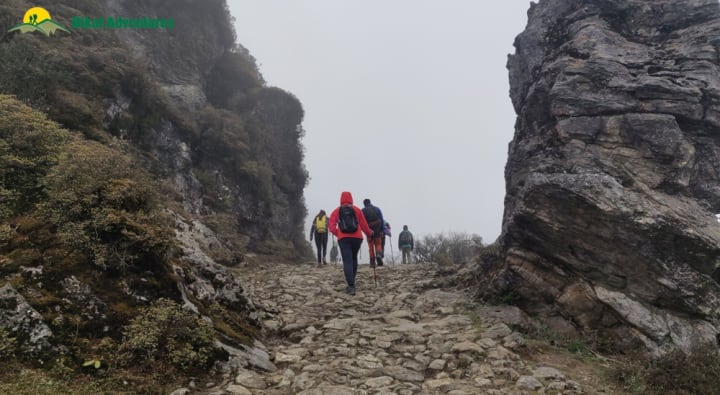
The Sandakphu Trek distance covers approximately 61 kilometers over 6–7 days. Starting from Jaubhari at 2,240 meters, the trail ascends to Sandakphu at 3,636 meters, making it a moderate to challenging trek.
The Sandakphu trek altitude profile is as follows:
- Jaubhari: 2,240 m
- Tumling: 2,875 m
- Kalapokhri: 2,990 m
- Sandakphu: 3,636 m
- Phalut: 3,600 m
- Gorkhey: 2,400 m
- Sepi: 1,900 m
This gradual ascent helps trekkers acclimatize well, reducing the risk of altitude sickness.
Detailed Sandakphu Trek Itinerary
Day 1: Arrival at Jaubhari (2,240 m)
Your Sandakphu Trek adventure begins with a scenic 5-hour drive from Bagdogra Airport to Jaubhari. This quaint village serves as the trailhead for the trek. Spend the evening acclimatizing and preparing for the journey ahead.
Day 2: Jaubhari (2,240 m) to Tumling (2,875 m)
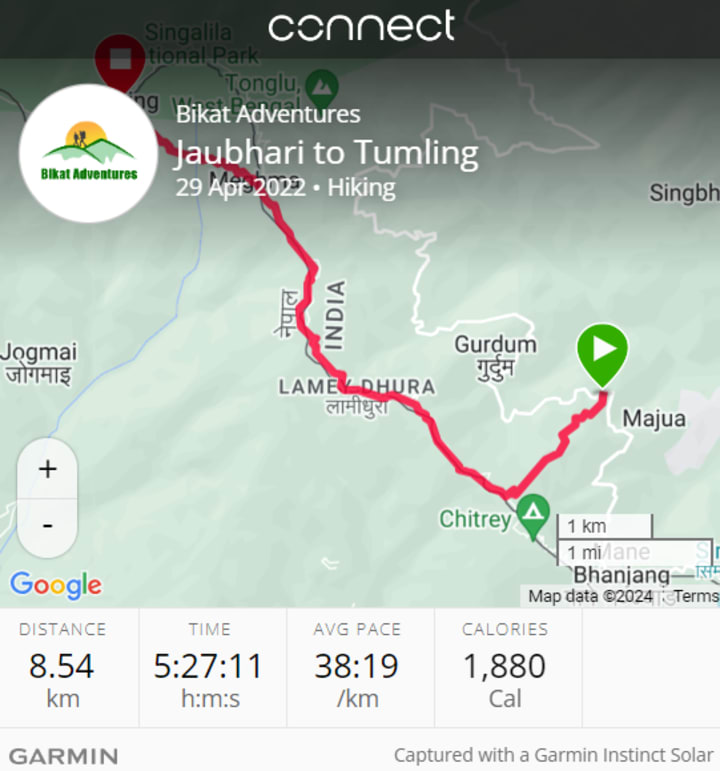
Distance: 9 km | Duration: 7–8 hours
Start early and trek through dense forests, crossing small villages like Chitrey and Lamaydhura. The trail offers glimpses of the Nepal border and diverse flora and fauna. Reach Tumling by afternoon for your first view of the majestic Kangchenjunga range.
Day 3: Tumling (2,875 m) to Kalapokhri (2,990 m)
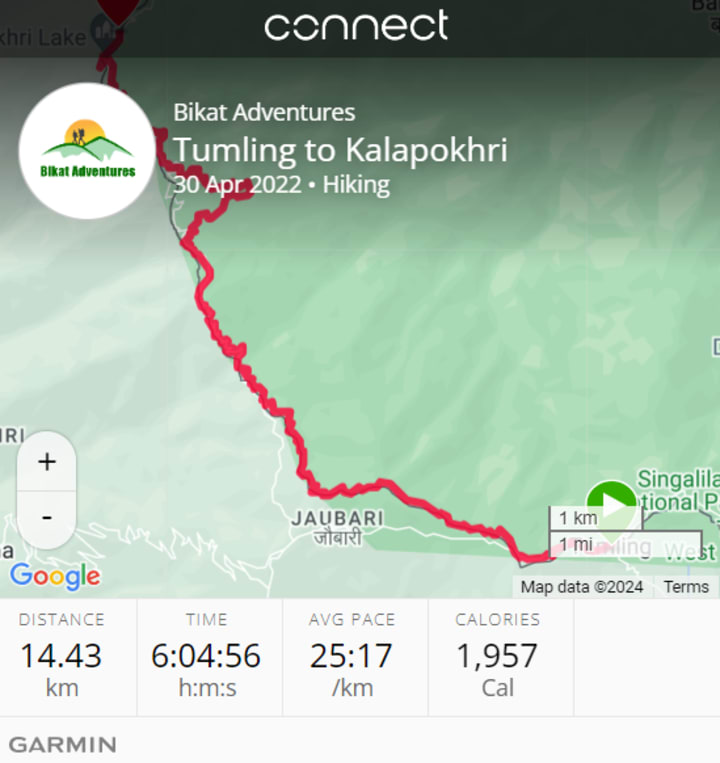
Distance: 15 km | Duration: 8 hours
Today’s trek takes you through the Singalila National Park. You’ll cross the Nepal border several times, offering unique cross-border experiences. The trail to Kalapokhri (Black Lake) is a mix of stone-paved paths and dirt trails, with stunning views of Mt. Everest on clear days.
Day 4: Kalapokhri (2,990 m) to Sandakphu (3,636 m)
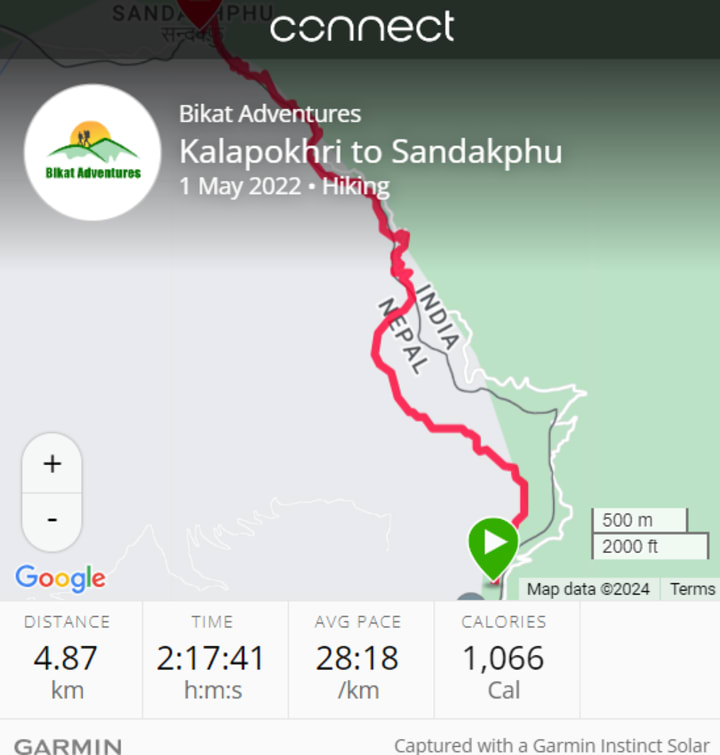
Distance: 5 km | Duration: 2–3 hours
A short but steep climb leads you to Sandakphu, the highest point of the trek. The panoramic view of four of the world’s five highest peaks from here is simply unmatched. Spend the evening soaking in the breathtaking sunset over the Himalayan range.
Day 5: Sandakphu (3,636 m) to Phalut (3,600 m)
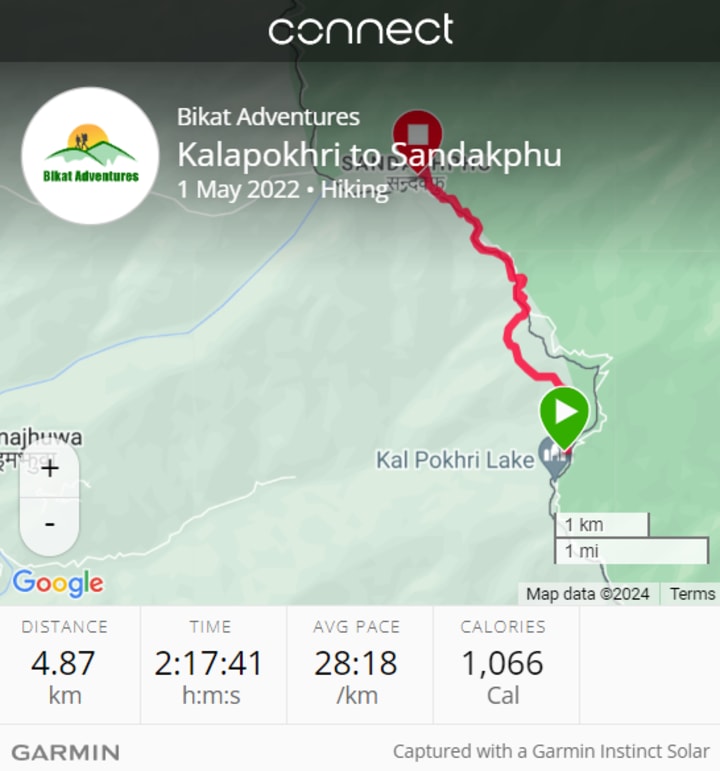
Distance: 20 km | Duration: 7–8 hours
The longest day of the trek offers continuous views of the Everest and Kangchenjunga massifs. In spring, the trail is adorned with blooming rhododendrons. Reach the isolated Phalut for an overnight stay amidst wilderness.
Day 6: Phalut (3,600 m) to Gorkhey (2,400 m)

Distance: 12 km | Duration: 4–5 hours
Descend through thick forests to reach the charming village of Gorkhey. The change in landscape from alpine to subtropical is remarkable. Enjoy the local culture and warm hospitality of the mountain people.
Day 7: Gorkhey (2,400 m) to Sepi (1,900 m)
Distance: 20 km | Duration: 7–8 hours
The final day of trekking takes you through picturesque villages of Samanden and Ramman before concluding at Sepi. From here, drive back to Bagdogra for your onward journey.
Sandakphu Trek Map and Navigation
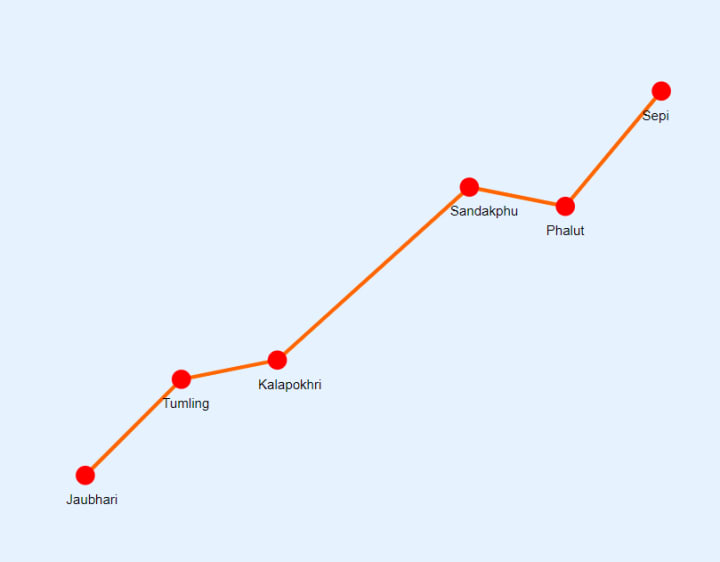
This Sandakphu trek map provides a visual overview of the route. The trek starts at Jaubhari and progresses through Tumling, Kalapokhri, Sandakphu (the highest point), Phalut, and finally ends at Sepi. Use this map in conjunction with detailed trail markers and guidance from your trek leader for safe navigation.
Remember that weather conditions can affect visibility and trail conditions. Always stay with your group and follow the instructions of your experienced guide.
Sandakphu Trek Price and Cost Breakdown
The Sandakphu trek price varies depending on the season and the services included. On average, you can expect to pay between INR 12,000 to INR 18,000 for a 7-day trek. This typically includes:
- Accommodation (mix of homestays and trekking huts)
- All meals during the trek
- Experienced trek leader and support staff
- Permits and entry fees
- Transportation from NJP/Bagdogra to Jaubhari and back
Additional costs to consider:
- Personal equipment and clothing
- Travel insurance
- Tips for staff (optional but customary)
To get the best Sandakphu trek price, book during the shoulder seasons (early March or late November) and look for early bird discounts.
Fitness Requirements and Preparation
The Sandakphu trek is considered moderate to challenging, requiring a good level of fitness. Here are some tips to prepare:
- Cardiovascular endurance: Build stamina through regular jogging, cycling, or swimming.
- Strength training: Focus on leg strength and core stability.
- Flexibility: Incorporate yoga or stretching exercises.
- Practice hikes: Take weekend hikes with a loaded backpack to simulate trek conditions.
- Altitude preparation: If possible, spend time at higher altitudes before the trek.
Start your fitness routine at least 2–3 months before the trek for optimal preparation.
Essential Gear for the Sandakphu Trek
Here’s a list of must-have items for your Sandakphu trek:
- Sturdy trekking boots
- Warm layers (thermal base layer, fleece, down jacket)
- Waterproof jacket and pants
- Trekking poles
- Sunglasses and sunscreen
- Headlamp with extra batteries
- Water bottles and water purification method
- First-aid kit
- Sleeping bag (if not provided by trek operator)
- Backpack and rain cover
Sandakphu Trek Booking Process
To book your Sandakphu trek:
- Research reputable trek operators.
- Choose your preferred dates
- Contact the operator for availability
- Complete the booking form and pay the deposit
- Receive a detailed itinerary and preparation guide
- Make final payment as per the operator’s policy
Book well in advance, especially for peak seasons, to secure your spot.
Sandakphu Trek Reviews and Experiences
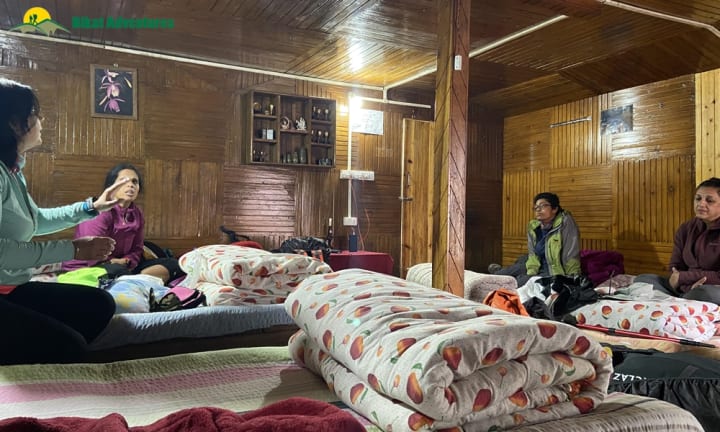
Many trekkers describe the Sandakphu trek as a life-changing experience. Here are some common highlights from Sandakphu trek reviews:
“The view of four 8000m peaks is simply breathtaking.”
“Loved the mix of Indian and Nepalese culture along the trail.”
“Challenging at times, but the sense of achievement is worth it.”
“The rhododendron forests in spring are like walking through a painting.”
Read detailed Sandakphu trek blogs providing valuable insights and tips from fellow trekkers.
Safety Tips for the Sandakphu Trek
- Acclimatize properly: Follow the itinerary and don’t rush ascent.
- Stay hydrated: Drink plenty of water throughout the trek.
- Protect from the sun: Use sunscreen, hat, and sunglasses.
- Dress in layers: Be prepared for rapidly changing weather.
- Follow guide instructions: They know the terrain and potential hazards.
- Inform about health issues: Let your trek leader know about any pre-existing conditions.
- Carry basic medications: For altitude sickness, diarrhea, and common cold.
Conclusion: Why Choose the Sandakphu Trek
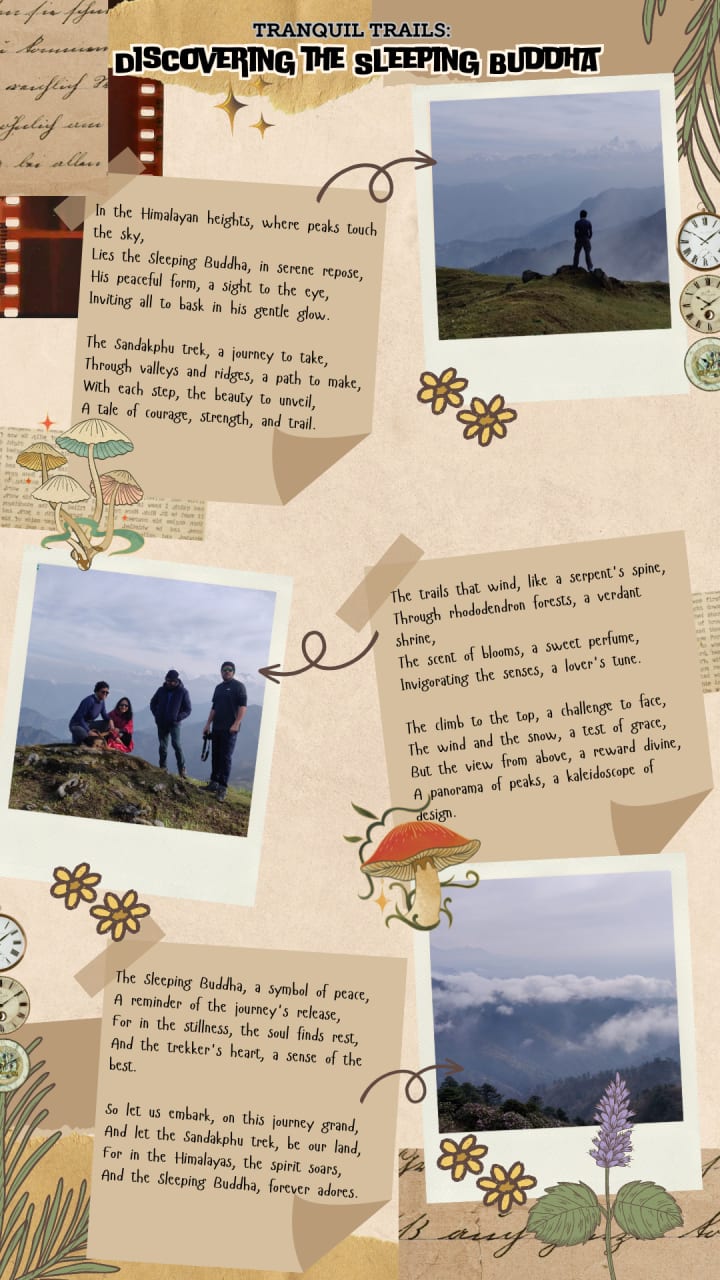
The Sandakphu trek offers a perfect blend of challenge and reward. From the stunning views of the world’s highest peaks to the rich biodiversity of the Singalila National Park, every step of this journey is filled with wonder. Whether you’re a seasoned trekker or a beginner looking for an adventure, the Sandakphu trek promises an unforgettable experience.
As you plan your Sandakphu trek for 2024, remember that proper preparation, respect for the mountains, and a spirit of adventure are key to making the most of this incredible journey. So lace up your boots, pack your backpack, and get ready for the trek of a lifetime in the magnificent Himalayas.

